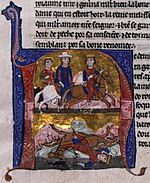King of Jerusalem facts for kids
Quick facts for kids King of Jerusalem |
|
|---|---|
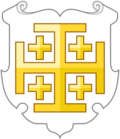
Royal coat of arms
(1280s) |
|
| Details | |
| First monarch | Godfrey of Bouillon |
| Last monarch | Henry II |
| Formation | 1099 |
| Abolition | 1291 |
| Residence | David's Tower |
| Appointer | Hereditary Election |
| Pretender(s) | Claimants |
The king or queen of Jerusalem was the main leader of the Kingdom of Jerusalem. This kingdom was a special state created by Crusaders. It was founded in Jerusalem by Latin Catholic leaders during the First Crusade. They captured the city in 1099.
Most rulers were men, but there were also five queens. Some queens ruled by themselves. Others ruled with their husbands, who became kings because they married the queen.
Godfrey of Bouillon was the first ruler of the Kingdom of Jerusalem. He did not want the title of king. Instead, he chose to be called "Advocate of the Church of the Holy Sepulchre". This meant he was the defender of this important church. In 1100, Baldwin I, Godfrey's brother, became the first ruler to be crowned king.
Jerusalem was lost to the Crusaders in 1187. However, their kingdom continued to exist. The capital moved to Acre in 1191. Crusaders briefly took Jerusalem back during the Sixth Crusade (1229–1239 and 1241–1244).
The Kingdom of Jerusalem finally ended in 1291. This happened with the fall of Acre. It marked the end of the Crusades in the Holy Land.
Even after the kingdom was gone, some European noble families still claimed the title "King of Jerusalem". These families were related to the kings of Cyprus or kings of Naples. Today, the current king of Spain also claims this title.
Who Were the Kings of Jerusalem?

The Kingdom of Jerusalem started during the First Crusade. People first thought about making Jerusalem a church-run state. But this idea was not chosen. In 1099, Godfrey of Bouillon was chosen as the first Latin ruler. He was made ruler in the Church of the Nativity in Bethlehem.
Godfrey chose the title "Advocate of the Holy Sepulchre". This meant he was the protector of the Church of the Holy Sepulchre. He likely chose this because some believed only Christ could wear a crown in Jerusalem. The term "Advocate" was common where the Crusaders came from. It meant a person who protected and managed church lands.
Godfrey died the next year. His brother, Baldwin I, was the first to use the title of king. He was also the first to be crowned king in Jerusalem itself. This happened in the Church of the Holy Sepulchre.
How Kings Were Chosen
The kingship of Jerusalem was a mix of being elected and inherited. In the mid-12th century, there was a royal family. This meant there was a clear line of who would rule next. However, the king still had to be chosen or approved by the Haute Cour. This was a special court of nobles.
In the Haute Cour, the king was seen as "first among equals". This means he was the leader, but still equal to the other powerful nobles. If the king was away, his duties were handled by his seneschal.
Life in the Royal Palace
From the 1160s, the royal palace was located south of Jerusalem's citadel. The Kingdom of Jerusalem brought French feudal ways of life to the Levant. This meant the king owned several fiefs (lands) that were part of his royal lands. These lands changed from king to king. The king was also in charge of leading the army into battle. Sometimes, a constable would take on this duty.
Unlike some European states that were becoming stronger, the king of Jerusalem often lost power. This power went to the strongest nobles, called barons. This happened partly because many kings were very young. Also, regents (people who ruled for a young king) were often chosen from these powerful nobles.
After Jerusalem fell in 1187, the capital moved to Acre. It stayed there until 1291. However, coronations (crowning ceremonies) still took place in Tyre.
During this time, the title of king was often just a name. It was held by European rulers who never actually lived in Acre. For example, when young Conrad III was king, he lived in Southern Germany. His father's cousin, Hugh of Brienne, claimed to be the regent. He also claimed his place in the line of succession. This claim was made in 1264. But the Haute Cour chose his cousin, Hugh of Antioch, instead. Hugh of Antioch later became Hugh III of Cyprus and Hugh I of Jerusalem.
After Conrad III was executed in 1268, the Lusignan family held the kingship. They were also kings of Cyprus at the same time. However, Charles I of Sicily bought the rights from one of the kingdom's heirs in 1277.
That year, Charles sent Roger of Sanseverino to the East. Roger captured Acre and forced the nobles to accept him. Roger was called back in 1282. He left Odo Poilechien in charge. Odo had little power. He was removed by Henry II of Cyprus when Henry arrived from Cyprus to be crowned King of Jerusalem.
Acre was captured by the Mamluks in 1291. This ended the Crusader presence on the mainland.
House of Boulogne (1099–1118)
| Monarch | Image | Birth | Marriages | Death |
|---|---|---|---|---|
| Godfrey 1099–1100 |
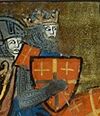 |
c. 1060 Flanders son of Eustace II, Count of Boulogne and Ida of Lorraine |
never married | 18 July 1100 Jerusalem aged about 40 |
| Baldwin I 1100–1118 |
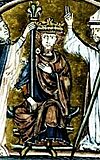 |
c. 1058 Lorraine, France son of Eustace II, Count of Boulogne and Ida of Lorraine |
Godehilde de Toeni no children Arda of Armenia 1097 no children Adelaide del Vasto 1112 no children |
2 April 1118 Arish, Egypt aged about 60 |
House of Rethel (1118–1153)
| Monarch | Image | Birth | Marriages | Death |
|---|---|---|---|---|
| Baldwin II 1118–1131 |
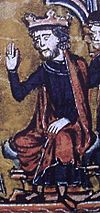 |
1075 France son of Hugh I, Count of Rethel and Melisende of Montlhéry |
Morphia of Melitene 1101 four daughters |
21 August 1131 Jerusalem |
| Melisende 1131–1153 with Fulk until 1143 with Baldwin III from 1143 |
 |
1105 Jerusalem daughter of King Baldwin II and Morphia of Melitene |
Fulk V, Count of Anjou 2 June 1129 2 sons |
11 September 1161 Jerusalem aged 56 |
House of Anjou (1153–1205)
In 1127, Fulk V, Count of Anjou, received a message from King Baldwin II of Jerusalem. Baldwin II had no sons. He had already chosen his daughter Melisende to rule after him. Baldwin II wanted to protect his daughter's right to rule. So, he planned for her to marry a powerful lord. Fulk was a rich Crusader and a skilled military leader. He was also a widower. His experience in battle would be very helpful in a kingdom often at war.
However, Fulk wanted more than just to be the Queen's husband. He wanted to be king alongside Melisende. Baldwin II agreed, thinking about Fulk's wealth and military skills. Fulk then gave up his titles to his son Geoffrey. He sailed to Jerusalem to become king. He married Melisende on June 2, 1129. Later, Baldwin II made Melisende the sole guardian of her son with Fulk, Baldwin III. This helped strengthen her position in the kingdom. Baldwin III was born in 1130.
Fulk and Melisende became joint rulers of Jerusalem in 1131 after Baldwin II died. At first, Fulk took full control of the government. He left Melisende out completely. He preferred people from his home region of Anjou over the local nobles. Other Crusader states to the north worried that Fulk would try to control them. Baldwin II had done this, but Fulk was less powerful. So, the northern states did not accept his authority.
In Jerusalem, people who had grown up there since the First Crusade did not like Fulk. These "natives" supported Melisende's cousin, Hugh II of Le Puiset, the count of Jaffa. Hugh was very loyal to the Queen. Fulk saw Hugh as a rival. In 1134, Fulk accused Hugh of being disloyal and a traitor. Hugh rebelled and joined forces with the Muslims of Ascalon. He managed to defeat the army Fulk sent against him. But this situation could not last. The Patriarch (a church leader) stepped in. He might have done this at Melisende's request. Fulk agreed to peace. Hugh was sent away from the kingdom for three years. This was a light punishment.
However, someone tried to kill Hugh. Many believed Fulk or his supporters were responsible, but there was no direct proof. This scandal was enough for the Queen's supporters to take over the government. It was like a takeover of the palace. Historian Bernard Hamilton wrote that Fulk's supporters "went in terror of their lives" in the palace. Another historian, William of Tyre, wrote that Fulk "never tried to do anything, even small things, without (Melisende's) permission." As a result, Melisende had full control of the government from 1136 onwards. Before 1136, Fulk and his wife made up. Their second son, Amalric, was born.
In 1143, while the king and queen were on vacation in Acre, Fulk died in a hunting accident. He was buried in the Church of the Holy Sepulchre in Jerusalem. Even though their marriage started with problems, Melisende grieved for him both privately and publicly. Fulk was survived by his son Geoffrey Plantagenet, Count of Anjou from his first wife. He also had Baldwin III and Amalric I with Melisende.
Baldwin III became king with his mother as co-ruler in 1143. His early rule had many arguments with his mother over who controlled Jerusalem. This lasted until 1153, when he took full control of the government. He died in 1163 without children. The kingdom then went to his brother, Amalric I. Some nobles did not like Amalric's wife, Agnes. They had accepted the marriage in 1157 when Baldwin III could still have children. But now, the Haute Cour refused to accept Amalric as king unless his marriage to Agnes was ended.
The dislike for Agnes might have been made bigger by the writer William of Tyre. She later stopped him from becoming the Latin Patriarch of Jerusalem. Also, William's followers hinted at problems with her character. They said, "there should not be such a queen for so holy a city as Jerusalem."
Still, being related by blood was enough for the opposition. Amalric agreed and became king without a wife. Agnes still kept the title Countess of Jaffa and Ascalon. She also received money from that land. The church decided that Agnes's children were legitimate. This meant they could still inherit the throne. Through them, Agnes had a lot of influence in Jerusalem for almost 20 years. Amalric was followed by his son with Agnes, Baldwin IV.

Amalric's first wife, Agnes of Courtenay, was now married to Reginald of Sidon. Maria Comnena, the former Queen, had married Balian of Ibelin in 1177. His daughter with Agnes, Sibylla, was old enough to rule. She had a son and was in a strong position to follow her brother. But Maria's daughter Isabella had the support of her stepfather's family, the Ibelins.
In 1179, Baldwin planned to marry Sibylla to Hugh III of Burgundy. But by spring 1180, this was still not settled. Raymond III of Tripoli tried to take power. He marched on Jerusalem with Bohemund III. They wanted to force the king to marry his sister to a local noble of Raymond's choice. This was likely Baldwin of Ibelin, Balian's older brother. To stop this, the king quickly arranged her marriage to Guy of Lusignan. Guy was the younger brother of Amalric, who was the kingdom's constable.
A marriage to someone from outside the kingdom was important. It could bring military help. The new French king Philip II was young. Guy was a vassal (a loyal follower) of the King of France. Sibylla's cousin, Henry II of England, also owed the Pope a special journey. This made Guy a useful choice.
By 1182, Baldwin IV was getting weaker from his leprosy. He named Guy as bailli (a kind of regent). Raymond disagreed with this. But when Guy lost favor with Baldwin the next year, Raymond was again made bailli. He was given control of Beirut. Baldwin made an agreement with Raymond and the Haute Cour. They decided to make Baldwin of Montferrat, Sibylla's son from her first marriage, his heir. This was to happen before Sibylla and Guy. The child was crowned co-king as Baldwin V in 1183. Raymond led the ceremony. They agreed that if the boy died young, the regency would go to "the most rightful heirs." This would last until his relatives – the Kings of England and France, Frederick I, Holy Roman Emperor, and the Pope – could decide between Sibylla's and Isabella's claims. These "most rightful heirs" were not named.
Baldwin IV died in spring 1185. His nephew took the throne. Raymond was bailli. But he gave Baldwin V's personal care to Joscelin III of Edessa, the boy's great-uncle. Raymond said he did not want people to suspect him if the child, who seemed weak, died. Baldwin V died in the summer of 1186 in Acre. Neither side paid attention to Baldwin IV's will.
After the funeral, Joscelin had Sibylla named as her brother's successor. But she had to agree to divorce Guy. This was like her father divorcing her mother. She was promised she could choose a new husband. Once crowned, she immediately crowned Guy. Meanwhile, Raymond went to Nablus, where Balian and Maria lived. He called together all the nobles loyal to Princess Isabella and the Ibelins. Raymond wanted Isabella and her husband Humphrey IV of Toron to be crowned instead. However, Humphrey, whose stepfather Raynald of Châtillon was Guy's ally, left Raymond. He swore loyalty to Guy and Sibylla.
| Monarch | Image | Birth | Marriages | Death | Notes |
|---|---|---|---|---|---|
| Fulk 1131–1143 with Melisende |
 |
1089/1092 Angers, France son of Fulk IV, Count of Anjou and Bertrade de Montfort |
Ermengarde of Maine 1109 4 children Melisende of Jerusalem 2 June 1129 2 sons |
13 November 1143 Acre, Kingdom of Jerusalem aged about 52 |
|
| Baldwin III 1143–1163 with Melisende until 1153 |
 |
1130 son of King Fulk and Queen Melisende |
Theodora Komnene 1158 no children |
10 February 1163 Beirut, Kingdom of Jerusalem aged 33 |
Crowned co-king with his mother Melisende on Christmas Day 1143 shortly after the death of his father Fulk. Just 13 year old when he ascended to the throne, he immediately had to deal with the loss of Edessa in 1144 and the Second Crusade through 1149. He engaged his mother in a civil war from 1152 to 1154, with the two eventually reconciling. He was responsible for the military first success after the Second Crusade, the siege of Ascalon of 1153, resulting in the capture of a strategic fortress from the Fatimids. In 1156, Baldwin was forced into a treaty with Nūr-ad-Din, and later entered into an alliance with the Byzantine Empire. Melisende died on 11 September 1161, and Baldwin succumbed two years later on 10 February 1163. Childless, he was succeeded by his brother, Amalric. |
| Amalric I 1163–1174 |
 |
1136 son of King Fulk and Queen Melisende |
Agnes of Courtenay 1157 3 children Maria Komnene 29 August 1167 2 children |
11 July 1174 Jerusalem aged 38 |
Crowned as King of Jerusalem on 18 February 1163. He married Agnes of Courtenay and, after an annulment, Maria Komnene. Three of Amalric's children would assume the throne of Jerusalem. He undertook a series of four invasions of Egypt from 1163 to 1169, taking advantage of weaknesses of the Fatimids. The campaign was generally indecisive, but did lay the groundwork for the takeover of Egypt by Saladin in 1171. Amalric died at a young age, on 11 July 1174, and was succeeded by his son Baldwin IV of Jerusalem. |
| Baldwin IV the Leprous 1174–1185 with Baldwin V from 1183 |
 |
1161 Jerusalem son of King Amalric and Agnes of Courtenay |
never married | 16 March 1185 Jerusalem aged 24 |
Became king on 5 July 1174 at the age of 13. As a leper he was not expected to live long, and served with a number of regents, and served as co-ruler with his cousin Baldwin V of Jerusalem beginning in 1183. Baldwin IV's rule began simultaneously with the death of Nūr-ad-Din and the rise of Saladin. Notably, Baldwin and Raynald of Châtillon defeated Saladin at the celebrated battle of Montgisard on 25 November 1177, and repelled his attacks at the battle of Belvoir Castle in 1182 and later in the siege of Kerak of 1183. He died on 16 March 1185. |
| Baldwin V 1183–1186 with Baldwin IV until 1185 |
 |
1177 son of William of Montferrat and Sibylla of Jerusalem |
never married | August 1186 Acre, Kingdom of Jerusalem aged 9 |
Became sole king upon the death of his uncle in 1185 under the regency of Raymond III of Tripoli. Raymond negotiated a truce with Saladin which went awry when Baldwin V died in the summer of 1186. He was succeeded in the kingdom by his mother Sibylla of Jerusalem—daughter of Amalric—and his stepfather, the French knight Guy of Lusignan. |
| Sibylla 1186–1190 with Guy |
 |
c. 1157 daughter of King Amalric and Agnes of Courtenay |
William of Montferrat, Count of Jaffa and Ascalon 1176 one son Guy of Lusignan April 1180 2 daughters |
25 July (probable), 1190 Acre, Kingdom of Jerusalem aged about 40 |
Crowned as queen and king of Jerusalem in the summer of 1186, shortly after the death of Baldwin V. They immediately had to deal with the threat posed by Saladin, and, in particular the battle of Hattin in 1187. During the battle Guy was captured, and remained in Saladin's custody until 1188. After the fall of Jerusalem, Sibylla fled to Tripoli, later joining Guy in Acre to meet the vanguard of the Third Crusade. She died on 25 July 1190. |
| Guy of Lusignan 1186–1190/1192 with Sibylla until 1190 |
 |
c. 1150 or 1159/1160 son of Hugh VIII of Lusignan and Bourgogne de Rançon |
Sibylla of Jerusalem April 1180 2 daughters |
18 July 1194 Nicosia, Cyprus aged about 45 |
|
| Isabella I 1190/1192-1205 with Conrad until 1192 with Henry II 1192–1197 with Amalric II from 1198 |
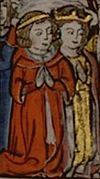 |
1172 Nablus, Kingdom of Jerusalem daughter of King Amalric I and Maria Komnene |
Humphrey IV of Toron November 1183 no children Conrad of Montferrat 24 November 1190 one daughter Henry II, Count of Champagne 6 May 1192 2 daughters Amalric of Lusignan January 1198 3 children |
5 April 1205 Acre, Kingdom of Jerusalem aged 33 |
Sister to Sibylla, became heiress to the kingdom upon her death, sometime after 25 July 1190. After much political haranguing, she married Conrad of Montferrat on 24 November 1190, with him become de jure king. In April 1192, Conrad was elected king but on 28 April 1192, he was felled by two Assassins before he could be crowned. His political rival Richard I of England was suspected as having supported the murder, a suspicion that remains unproven. |
| Conrad I of Montferrat 1190/1192–1192 with Isabella I |
mid-1140s Montferrat, Holy Roman Empire son of William V, Marquess of Montferrat and Judith of Babenberg |
unidentified woman before 1179 no children Theodora Angelina 1186/1187 no children Isabella I of Jerusalem 24 November 1190 one daughter |
28 April 1192 (murdered) Acre, Kingdom of Jerusalem aged mid-40s |
||
| Henry I of Champagne 1192–1197 with Isabella I |
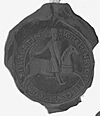 |
29 July 1166 Champagne son of Henry I, Count of Champagne and Marie of France |
Isabella I of Jerusalem 6 May 1192 2 daughters |
10 September 1197 Acre, Kingdom of Jerusalem aged 31 |
Became king on 5 May 1192 when he married Isabella. Henry was the nephew of both Richard I of England and Philip II of France, but did not use the royal title. He died in Acre on 10 September 1197 after a fall from his window at the palace in Acre. |
| Aimery/Amalric II of Lusignan 1198–1205 with Isabella I |
 |
1145 son of Hugh VIII of Lusignan and Bourgogne de Rançon |
Éschive d'Ibelin before 29 October 1174 6 children Isabella I of Jerusalem January 1198 3 children |
1 April 1205 Acre, Kingdom of Jerusalem aged 60 |
As Isabella's next husband, they were crowned king and queen of in January 1198. A former commander at the Battle of Hattin of 1187 as well as King of Cyprus since the death of Guy of Lusignan in 1194, his rule was a period of peace and stability in both of his realms. In particular, he signed a truce with al-Adil, now Ayyubid sultan of Egypt in 1198 which secured the Christian possession of the coastline from Acre to Antioch. This truce essentially prevented the remnants of the Fourth Crusade from their mission. He died on 1 April 1205. His son Hugh I of Cyprus succeeded him in Cyprus, while Isabella I continued to rule the Kingdom of Jerusalem. Isabella died four days later on 5 April 1205 and was succeeded by her daughter by Conrad, Maria of Montferrat, who served through 1212, with her husband John of Brienne after 1210. |
Houses of Aleramici and Brienne (1205–1228)
| Monarch | Image | Birth | Marriages | Death |
|---|---|---|---|---|
| Maria 1205–1212 with John I from 1210 |
 |
1192 daughter of Conrad of Montferrat and Queen Isabella |
John of Brienne 14 September 1210 one daughter |
1212 aged 20 |
| John I 1210–1212 with Maria |
c. 1170 son of Erard II of Brienne and Agnes de Montfaucon |
Maria of Jerusalem 14 September 1210 one daughter Stephanie of Armenia one son Berengaria of León 1224 4 children |
27 March 1237 aged about 67 |
|
| Isabella II also called Yolande 1212–1228 with Frederick from 1225 |
 |
1212 daughter of John of Brienne and Queen Maria |
Frederick II, Holy Roman Emperor 9 November 1225 2 children |
25 April 1228 Andria, Kingdom of Sicily aged 16 |
| Frederick 1225–1228 with Isabella II |
 |
1194 son of Henry VI, Holy Roman Emperor and Constance of Sicily |
Constance of Aragon 15 August 1209 one son Isabella II of Jerusalem 9 November 1225 2 children Isabella of England 15 July 1235 4 children |
13 December 1250 Apulia, Kingdom of Sicily aged 55 |
House of Hohenstaufen (1228–1268)
| Monarch | Image | Birth | Marriages | Death |
|---|---|---|---|---|
| Conrad II 1228–1254 |
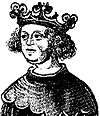 |
25 April 1228 Andria, Kingdom of Sicily son of Frederick II, Holy Roman Emperor and Queen Isabella II |
Elisabeth of Bavaria 1 September 1246 one son |
21 May 1254 Lavello, Kingdom of Sicily aged 26 |
| Conrad III 1254–1268 |
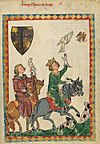 |
25 March 1252 Wolfstein Castle, Landshut, Bavaria, Holy Roman Empire son of King Conrad II and Elisabeth of Bavaria |
never married | 29 October 1268 Castel dell'Ovo, Naples, Kingdom of Sicily aged 16 |
House of Lusignan (1268–1291)
| Monarch | Image | Birth | Marriages | Death |
|---|---|---|---|---|
| Hugh 1268–1284 |
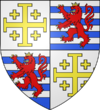 |
1235 son of Henry of Antioch and Isabella of Cyprus, a granddaughter of Queen Isabella I |
Isabella of Ibelin after 25 January 1255 11 children |
24 March 1284 Nicosia, Cyprus aged 49 |
| John II 1284–1285 |
 |
1259/1267 son of King Hugh and Isabella of Ibelin |
never married | 20 May 1285 Nicosia, Cyprus aged 17 or 26 |
| Henry II 1285–1324 in title only after 1291 |
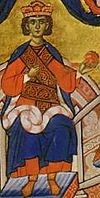 |
1271 son of King Hugh and Isabella of Ibelin |
Constance of Sicily 16 October 1317 no children |
31 August 1324 Strovolos, Cyprus aged 53 |
Regents Who Ruled for Kings
Kings of Jerusalem were often away or too young to rule. Because of this, regents were chosen many times. A regent is someone who rules for the king or queen when they cannot.
| Regent | Regent for | Relation to the monarch | Became regent | Regency ended |
|---|---|---|---|---|
| Eustace Grenier, Constable of the Kingdom | Baldwin II | – | 1123 King held captive by the Ortoqids |
1123 death |
| William I of Bures, Prince of Galilee | – | 1123 King held captive by the Ortoqids |
1124 return of the King from captivity |
|
| Queen Melisende | Baldwin III | mother | 1154 as the King's advisor |
1161 death |
| Raymond III, Count of Tripoli | Baldwin IV | cousin | 1174 King was a minor |
1176 King became an adult |
| Guy of Lusignan | brother-in-law | 1182 appointed by the King due to illness |
1184 removed by the King |
|
| Raymond III, Count of Tripoli | Baldwin V | first cousin once removed | 1185 King was a minor |
1186 death of the King |
| John of Ibelin, the Old Lord of Beirut | Maria | half-uncle | 1205 Queen was a minor |
1210 Queen became an adult |
| King John I | Isabella II | father | 1212 Queen was a minor |
1225 the Queen's marriage |
| Frederick II, Holy Roman Emperor | Conrad II | father | 1228 King was a minor |
1243 King became an adult |
| Alice of Champagne, Queen of Cyprus | half-aunt | 1243 King was absent |
1246 death |
|
| Henry I of Cyprus | half-cousin; son of Alice and Hugh I | 1246 King was absent |
1253 death |
|
| Plaisance of Antioch, dowager Queen of Cyprus | half-cousin-in-law | 1253 King was absent/minor |
1261 death |
|
| Conrad III | half-cousin-in-law once removed | |||
| Isabelle de Lusignan | half-cousin once removed; daughter of Alice | 1261 King was a minor |
1264 death |
|
| Hugh of Antioch | half-second cousin; son of Isabelle | 1264 King was a minor |
1268 death of the King, ascension to the throne |
Later Claims to the Throne
Even after the Kingdom of Jerusalem ended, many European rulers said they were the rightful heirs. However, none of these people ever actually ruled any part of the Outremer (the Crusader lands).
- Count Hugh of Brienne claimed to be the regent of the Kingdom of Jerusalem in 1264. He also claimed his place in the line of succession. He was a senior heir of Alice of Jerusalem, who was the second daughter of Queen Isabella I. Hugh was the son of Alice's oldest daughter. But the Haute Cour chose his cousin, Hugh of Antioch, instead. Hugh of Antioch later became Hugh III of Cyprus and Hugh I of Jerusalem. The Brienne family continued to claim the title, but they had almost no role in the Crusader lands after that.
- Frederick of Meissen, a ruler in Germany, briefly used the title of King of Jerusalem. He did this after Conradin died in 1268. Frederick was the grandson of Frederick II, who had crowned himself King of Jerusalem. But this claim was never recognized by anyone in the Crusader lands or elsewhere.
- After the kingdom ended, Henry II of Cyprus kept using the title of King of Jerusalem. After he died, his successors, the kings of Cyprus, also claimed the title.
- The title was also used by the Angevin kings of Naples in Italy. Their first king, Charles I of Anjou, bought a claim to the throne in 1277 from Mary of Antioch. After that, this claim to the Kingdom of Jerusalem was treated as part of the crown of Naples. The crown of Naples often changed hands through wills or conquests, not just direct inheritance. Since Naples was under the Pope's authority, Popes often supported the title of King of Jerusalem as well as Naples. The history of these claims is tied to the Kingdom of Naples. When they were removed from power, the Habsburg Emperors of Austria used the title "King of Jerusalem". So did the Savoyard kings of Italy. Today, the title is among those claimed by Felipe VI of Spain.
- In 1948, King Abdullah I of Jordan was crowned king of Jerusalem by the Coptic bishop.
See also
 In Spanish: Anexo:Reyes de Jerusalén para niños
In Spanish: Anexo:Reyes de Jerusalén para niños
- List of queens of Jerusalem
- Family tree of Kingdom of Jerusalem monarchs
- Timeline of the Kingdom of Jerusalem


